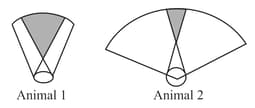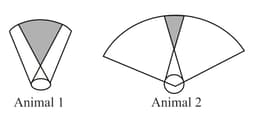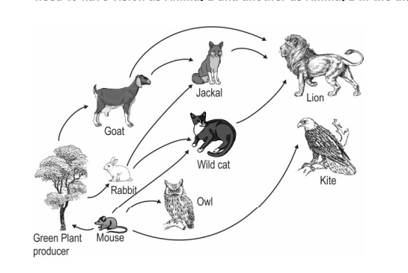Answer the following question based on the information given below:
Shown here is the extent to which two different animals can see in either direction without turning their heads. In animal 1, the eyes are placed towards the front of the head, and animal 2; the eyes are placed on either side of the head.
Since the placement of eyes in the two animals is different, their vision is also slightly different.

In the figure above, the grey part represents the part that both eyes can see at a time, while the white part represents those parts that can be seen only by one eye at a time.
Animal 2 can see a broader area at any time compared to animal 1. Animal 1 can distinguish depth better compared to animal 2.
Based on this, which of the following two animals is most likely to be a Predator and why?
Shown here is the extent to which two different animals can see in either direction without turning their heads. In animal 1, the eyes are placed towards the front of the head, and animal 2; the eyes are placed on either side of the head.
Since the placement of eyes in the two animals is different, their vision is also slightly different.

In the figure above, the grey part represents the part that both eyes can see at a time, while the white part represents those parts that can be seen only by one eye at a time.
Animal 2 can see a broader area at any time compared to animal 1. Animal 1 can distinguish depth better compared to animal 2.
Based on this, which of the following two animals is most likely to be a Predator and why?

Important Questions on Our Environment
Answer the following question based on the information given below:
Shown here is the extent to which two different animals can see in either direction without turning their heads. In animal 1, the eyes are placed towards the front of the head, and animal 2; the eyes are placed on either side of the head.
Since the placement of eyes in the two animals is different, their vision is also slightly different.

In the figure above, the grey part represents the part that both eyes can see at a time, while the white part represents those parts that can be seen only by one eye at a time.
Animal 2 can see a broader area at any time compared to animal 1. Animal 1 can distinguish depth better compared to animal 2.
Observe the following food web. Classify the animals into two groups - one that would need to have a vision as animal 1 and another as animal 2 in the diagram above:

Arrange the four objects given above according to the time they take to get biodegraded(LEAST time TO MOST time).
| Bone | Metal can | Paper sheet | Plastic bottle |
Based on energy transfer in a food chain, what could be the most likely reason for the above statement?
